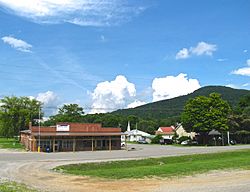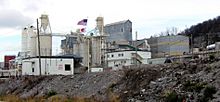Crab Orchard, Tennessee facts for kids
Quick facts for kids
Crab Orchard, Tennessee
|
|
|---|---|

Main Street in Crab Orchard
|
|
| Nickname(s):
Stone Capital of Tennessee
|
|

Location of Crab Orchard in Cumberland County, Tennessee.
|
|
| Country | United States |
| State | Tennessee |
| County | Cumberland |
| Settled | 1780s |
| Incorporated | 1921 |
| Named for | Crab apple trees |
| Area | |
| • Total | 10.94 sq mi (28.32 km2) |
| • Land | 10.94 sq mi (28.32 km2) |
| • Water | 0.00 sq mi (0.00 km2) |
| Elevation | 1,677 ft (511 m) |
| Population
(2020)
|
|
| • Total | 720 |
| • Density | 65.84/sq mi (25.42/km2) |
| Time zone | UTC-6 (Central (CST)) |
| • Summer (DST) | UTC-5 (CDT) |
| ZIP code |
37723
|
| Area code(s) | 931 |
| FIPS code | 47-17840 |
| GNIS feature ID | 1281520 |
Crab Orchard is a small city in Cumberland County, Tennessee, United States. It's known as the "Stone Capital of Tennessee." In 2020, about 719 people lived there.
This city is located in a special gap in the mountains. This made it an important pathway for travelers long ago.
Contents
History of Crab Orchard
Crab Orchard got its name from the many wild crab apple trees that grew there. Early pioneers, who were settlers moving into new lands, saw these trees.
Early Roads and Travelers
In the 1780s, a road was built through the mountain gap. This road helped protect people traveling from East Tennessee to the Nashville area. It was a busy route for pioneers.
Later, around the late 1700s, the Walton Road was built. This was part of a system of roads for stagecoaches. Stagecoaches were like early buses that carried people and mail. This road connected Knoxville and Nashville, bringing many travelers through Crab Orchard.
Around 1800, Sidnor's Inn opened in Crab Orchard. An inn is like a hotel for travelers. Bishop Francis Asbury, a famous religious leader, was one of its first guests. In 1827, the Crab Orchard Inn also opened and stayed open for many years.
Native American Interactions
In the early 1790s, there were some conflicts between Native American groups and the European-American settlers moving into the area. These groups included the Cherokee, Creek, and Shawnee.
There were reports of clashes near Crab Orchard during this time. For example, Captain Samuel Handley's group of soldiers had a conflict with Native American warriors. Also, a group of travelers faced a conflict with Creek warriors. These events show the challenges of settling new lands.
Famous Crab Orchard Stone
Crab Orchard became famous for a special type of strong sandstone found nearby. This stone was first used in local buildings and sidewalks in the late 1800s.
It became very popular in the 1920s. It was used to build Scarritt College in Nashville. Many buildings in the nearby city of Crossville are also made with Crab Orchard stone.
Today, Crab Orchard is home to a large limestone mine. This mine is run by Lhoist North America. You can see the mine and its plant along Interstate 40 and US-70.
Geography of Crab Orchard
Crab Orchard is located on top of the Cumberland Plateau. It sits in a gap within the Crab Orchard Mountains. These mountains are part of the larger Cumberland Mountains.
This mountain gap has always been an important path. Travelers used it to go between East and Middle Tennessee. Today, major highways like Interstate 40 and U.S. Route 70 pass through the city.
Nearby Mountains
To the north of Crab Orchard, you can see Big Rock Mountain. It stands tall at about 2,703 feet (824 meters). To the south, Haley Mountain (2,660 feet or 811 meters) and Black Mountain (2,827 feet or 862 meters) are prominent.
A part of the Cumberland Trail will eventually go through Crab Orchard. This trail is a long hiking path.
Land Area and Climate
The city of Crab Orchard covers about 11.1 square miles (28.32 square kilometers). All of this area is land. There are no large bodies of water within the city limits.
Crab Orchard has a humid subtropical climate. This means it has hot, humid summers. The winters are usually mild to cool.
Population and People
The population of Crab Orchard has changed over the years. Here's how it has looked:
| Historical population | |||
|---|---|---|---|
| Census | Pop. | %± | |
| 1980 | 1,065 | — | |
| 1990 | 876 | −17.7% | |
| 2000 | 838 | −4.3% | |
| 2010 | 752 | −10.3% | |
| 2020 | 720 | −4.3% | |
| Sources: | |||
Who Lives in Crab Orchard?
According to the 2020 United States census, there were 719 people living in Crab Orchard. These people made up 282 households and 189 families.
Most people in Crab Orchard are White (non-Hispanic), making up about 92.5% of the population. There are also smaller numbers of people from other racial and ethnic backgrounds.
| Race | Number | Percentage |
|---|---|---|
| White (non-Hispanic) | 665 | 92.5% |
| Black or African American (non-Hispanic) | 1 | 0.14% |
| Native American | 1 | 0.14% |
| Asian | 2 | 0.28% |
| Other/Mixed | 29 | 4.03% |
| Hispanic or Latino | 21 | 2.92% |
See also
 In Spanish: Crab Orchard (Tennessee) para niños
In Spanish: Crab Orchard (Tennessee) para niños


